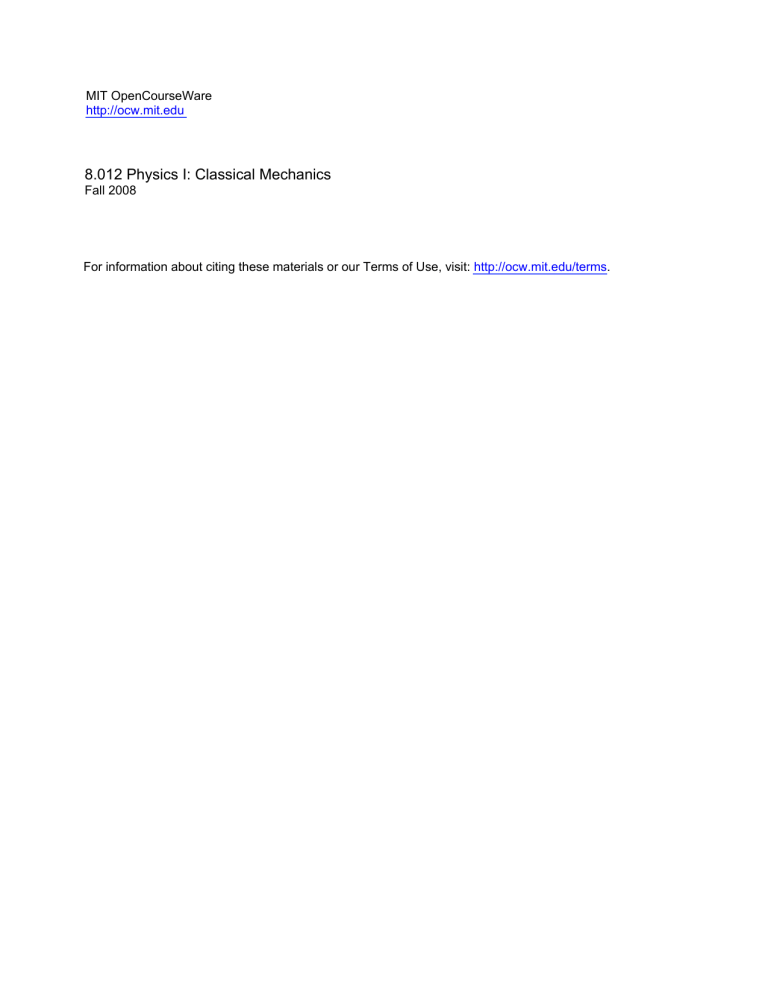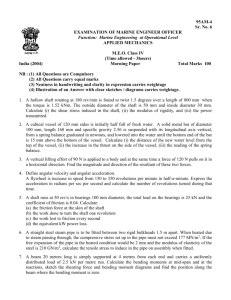8.012 Physics I: Classical Mechanics MIT OpenCourseWare Fall 2008

MIT OpenCourseWare http://ocw.mit.edu
8.012 Physics I: Classical Mechanics
Fall 2008
For information about citing these materials or our Terms of Use, visit: http://ocw.mit.edu/terms .
Physics 8.012
MASSACHUSETTS INSTITUTE OF TECHNOLOGY
Department of Physics
MIDTERM EXAM 1
Thursday, October 6, 2005
Fall 2005
Name:
(Please write your name in ALL CAPITALS)
Instructions:
•
Do all FIVE (5) problems. You have 90 minutes.
•
SHOW ALL WORK, and circle your answer.
•
All work must be done in this booklet. Extra blank pages are provided.
•
The exam is closed-book and closed-notes. Calculators are not permitted.
Problem Maximum Score Grader
1
2
3
4
5
TOTAL
10
20
20
25
25
100
Useful Relations
•
Velocity in polar coordinates r ˙ = r ˙ˆ + rθ
•
Acceleration in polar coordinates
¨ r
− rθ
˙ 2 ) ˆ + (
¨ rθ ˙) ˆ
1. Problem 1 of 5
Short answer questions. (10 points)
Note: DO NOT spend too much time on this problem!
It is worth fewer points than the other 4 problems.
For each question, circle the correct answer:
(a) (2 points) A bee and a train collide. Compared to the magnitude of the force experienced by the bee, the magnitude of the force experienced by the train is smaller larger equal dependent on other details
(b) (2 points) A point mass m is placed inside a thin spherical shell of mass M and radius
R , at a distance R/ 2 from the center. Let ˆ be a radial unit vector pointing from the point mass away from the center of the shell. The gravitational force exerted on the point mass by the spherical shell is
−
4 GM m
R 2
−
GM m
R 2 zero +
GM m
R 2
+ 4 GM m
R 2
(c) (2 points) A mass M suspended from the ceiling by a spring (with spring constant k ) undergoes simple harmonic motion with an oscillation period P . If the mass is doubled, then the new oscillation period is
P/ 2 P/
√
2 P P
√
2 2 P
(d) (2 points) A block of mass M slides down a inclined plane with friction coefficient µ .
The surface area of the block in contact with the inclined plane is A , and the frictional force on the block is f . If we use a different block (made of the same material) with contact area 2 A but the same mass M , then the frictional force on the second block will be approximately f / 4 f / 2 f 2 f 4 f
(e) (2 points) When a mass moves through air or fluid at low velocity, it experiences a viscous drag force. (This is different than the turbulent drag felt at high velocity.) For a low velocity v , the viscous drag force is approximately proportional to v v 2 v 3 v 4 v 5
2. Problem 2 of 5
Masses on an accelerating pulley. (20 points)
Masses M
1 and M
2 are connected by a massless, inextensible string over a frictionless pulley of negligible mass. The pulley accelerates upward with constant acceleration A due to an external force. Gravity is directed downward.
(a) (5 points) Draw the force diagrams for M
1 and M
2
.
(b) (15 points) Find the accelerations of M
1 and M
2 in the inertial x y reference frame shown.
3. Problem 3 of 5
Ant on a spinning turntable. (20 points)
An ant of mass M is walking along a radial line painted on a horizontal disk that is rotating with constant angular velocity Ω. The ant is moving toward the center of the disk with constant radial speed v along the painted line, having started at r = r
0 at time t = 0. You may assume that gravity is directed downward and that the friction is high enough that the ant never slips. Find the magnitude of the force on the ant at a time t > 0 before it reaches the center of the disk.
4. Problem 4 of 5
Dog on a springy leash. (25 points)
A dog with mass M has its leash attached to one end of a spring which runs without friction along a horizontal overhead rod. The other end of the spring is fixed to a wall. The spring constant is k . The leash is stiff, massless and inextensible, and it maintains a constant angle θ with the overhead rod, even when the dog moves. There is friction with coefficient µ between the dog and the ground. Gravity is directed downward.
(a) (10 points) Draw force diagrams for the dog and the spring.
(b) (15 points) What is the maximum distance that the dog can stretch the spring beyond its rest length?
5. Problem 5 of 5
Spinning masses. (25 points)
Two equal masses m are attached by hinges and massless rods of length L to a rotating shaft and to a mass M which rotates with the shaft but is free to slide up it without friction. The upper rods are hinged to a fixed point on the shaft. At low angular velocity ω , the mass M sits on a seat attached to the shaft and the rods make a 45 ◦ angle with the shaft, as shown.
However, if ω exceeds a particular value ω
0
, then the mass M is no longer in contact with its seat but instead begins to slide up the shaft (thus increasing the angle between the rods and the shaft). Gravity acts downwards.
(a) (8 points) Draw force diagrams for the three masses.
(b) (8 points) Write down the equations of motion for each of the masses at low angular velocity ω , when the mass M sits on the seat.
(c) (9 points) Calculate the critical angular velocity ω
0 at which the mass M just begins to rise off the seat and up the shaft.
Hint: The tension in the upper rods is not equal to the tension in the lower rods.



